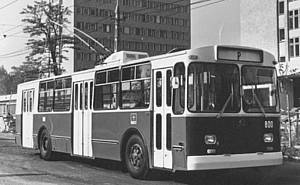 |
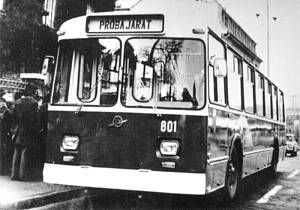 |
|
|
|
|
|
The
ZIU-9 type trolleybus in Hungary
Budapest - Szeged - Debrecen |
|
ZIU-9 trolleybuses in Budapest
 |
 |
|
|
|
After the city council has decided to keep the trolleybuses running in 1974, soon new Ikarus prototype trolleybuses were constructed: the articulated 100 and the solo 600. These cars ran without great problems, however the city council also was looking for new trolleybuses in the COMECON countries. By these years, the factory Uritsky in the Sowiet Union has started the mass production of the ZIU-9 type, which was the successor of the ZIU-5 type. The factory was not just able to produce some hundreds of trolleybuses yearly, the price of their product was considerably cheaper than self-assembling Ikarus solo trolleybuses with sowiet electric equippment.
The first two ZIU-9 trolleybus for Budapest were made in 1975, and was taken in the fleet on 31st October, 1975 with numbers 800-801. The Budapest Transportation Company (BKV) bought alltogether 172 ZIU-9 trolleybuses between 1975 and 1982. The very last trolleybus from the Sowiet Union (972) was a unique type.
Purchasing of ZIU-9 trolleybuses at the BKV:The batches comming in different years were slightly different, as the factory used newer technologies in the production. Such difference were introduced from 1977 and 1982. The BKV, during the first reconstructions in the '80s has unified and modified the trolleybuses, using partially Hungarian parts instead of the original. About the technical details and the modifications one can read later here.
year 1975 1976 1977 1978 1979 1980 1982 1984 number of new trolleybuses 2 54 36 14 16 25 25 1 fleet numbers 800-801 802-855 856-891 892-905 906-921 922-946 947-971 972
The new cars ran in the '80s on line 70, 72, 73, 74, 76, 77, 78, 82, 83, and also the line 79 the ZIU-9 ran mixed up with articulated cars. With the decreasing of the fleet and the arrival of the new GVM and Kiepe trolleybuses, in the '90s this solo type ran only in the city-centre (70, 73, 74, 74A, 76, 78). Today (2003) they run on lines 73, 74, 74A, 76 and in weekdays on 78 according the schedule.
The scrapping of the ZIU-9 started in 1984, and lasts until nowadays. These trolleybuses run now well over their orginally intended lifetime, in 2003 the oldest trolleybus in the fleet (882) has reached the age of 26.
Scrapping of the ZIU-9 type:Detailed fleet dataIn 2003 there are 50 ZIU-9 trolleybuses in everyday traffic, and 2 learner cars.
year 1984 1987 1988 1989 1990 1993 1994 1995 1996 1998 1999 2001 2002 2003 number of scrapped vehicles 8* 6 6** 5 24 17 1 12 9 6 8 6 10 3
* - 3 pcs. sold to Szeged
** - 3 pcs. sold to Debrecenbe
After the arrival of the last batch in 1982, one last ZIU tolleybus was bought by the BKV, which obtained the number 972 in 1984. However, this trolleybus was different, its electric equippment was modified comparing to the original ZIU-9B type. It had stronger, 150 kW motor. It was bought for experimental reasons, because at the time the BKV seriously considered the electrification of the Buda-hill autobus lines. The disadvantage of the construction of the ZIU-9, that there are three separate auxiliary motors for the compressor, the generator and the servo. In the construction of the ZIU-9V, these were operated from the motor through V-belts. Also the rheostatic brake was modified: the original two stage brake (which is regulated only by the contactors) was replaced by a more powerful braking, where also the starter was in the regulating circuit. Later similar equippment was introduced on the articulated IK-280 trolleybus 199, and also on the ZIU-9 trolleybus 9-139 in Szeged. Everywhere the tests gave bad results: because of the malfunctions of the rheostatic circuit, the trolleybuses made uncontrollable decelerations with blocking brakes.The last (ZIU-9V type) trolleybus: the 972
As the testruns lasted longer than expected, the trolleybus was not taken in service for more than a year after its delivery. At last in 1984 it was put in service, according to some sources after the exchange of its equippment and motor with usual ZIU-9 type. Today one can see no sign of the strange life of this trolleybus.
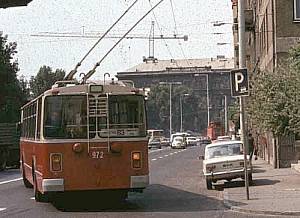 |
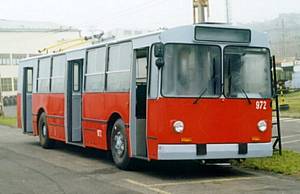 Dániel Szigeti
|
|
|
|
Two trolleybuses (886, 930) seriously burned out in the '80s, which were rebuilt later. With the reparation works, the pneumatic system of these trolleybuses were modified such, that instead of the usual mechanical hand-brakes they obtained pneumatic spring-force storing park-brakes (as it was common on Ikarus buses and trolleybuses). These ZIUs had three-panel dashboards in the driving cabins of the Ikarus-200 types, so the driver could get in trouble finding the different switches and buttons. The pedals remained on the two side of the steering wheel (as on the russian trolleybus types), but also Ikarus type brake pedal were installed. According to the description of the drivers, the 886 had the most comfortable pedals in the whole fleet: as on an ordinary ZIU often it is almost impossible to decelerate smoothly because of the rigidness of the pedal, on 886 the air-pressure on the brake was possible to regulate extremly softly.ZIU-9 trolleybuses without handbrakes
The two cars were scrapped in 2003.
It is not without precedence, that a company sends its car to another city for reparation works. Part of the Szeged fleet was repaired in Budapest, furthermore originally in the '70s a company in Pécs (in south Hungary, where there is no trolleybus service) was set to be the base of the reparation works of the trolleybuses. In 1998, the 887 from Budapest (bought in 1977) was sent Szeged for refurbishment. Naturally the chassis of this trolleybus was very worn and corrodated. However in Szeged, they were about to scrap the 9-138 (bought in 1983). So they decided to swap the two cars: the original 887 was sent to dismantle, and the ex-Szeged car was refurbished as 887II. The equippment of this car was changed according to the usual in Budapest (e.g. with 600 V pump motor for the steering-servo). The trolleybus was put back in service in 1999, but it is still considerably different form the usual ZIU-9s of Budapest.A ZIU from Szeged in the Budapest fleet
The last time ZIUs were reconstructed in 2000, with the help of the Enviromental Fund, the electric equippment of the cars were modified. The majority of the relays were replaced by a microprocessor driven electronical unit, which not just adjust the contactors and the servo-controller, but also regulates the index lamps and the light. It also watches the opened state of the doors. The prototype of this modification was the learner car 833, which was followed by a batch of ten trolleybuses (908, 923, 925, 931, 941, 955, 960, 966, 967, 969).Microprocessor driven ZIUs
This unit regulates the turn of the starter (servocontroller) comparing to the cars actual speed, giving constant acceleration independent of the weight of the load. It is also possible to stop the starter on the certain resistor cascade of the coupling process. This way the coupling became faster, e.g. on a section insulation the car does not start the acceleration process form zero. The trolleybus does not accelerate above 50 km/h, and it does not allow starting with open doors. The doors can be closed only after the pushing of the starting signal. Its main disadvantage, that the electronics does not operate any park-brake, so after a possible prohibition of start, the car can roll away. These trolleybuses can go only with truned on frontal lights, and the index heat-relay also disapperad (which very often in malfunction). Practically only these ZIU-9 trolleybuses have working speedmeter.
Originally there were some problems with the fine tuning of the electronics (the cars often prohibited the start without reason), by this time these trolleybuses run problemless.
In 1977, two cars were taken from the passenger service, and converted to learner trolleybuses. These cars were the 831 and 832.Learner cars
Possibly from 1984 after the scrappings and reconstructions even further cars were used as learner cars: such as the 833, 839 and 840; furthermore sometimes the 837 was also used for learning purposes (this latter trolleybus was used in 1979 to experiment with the BBC petrol-aggregate for off-wire operations).
Today (2003) there are two learner cars are in the fleet: the 833 and the 840. The 833 was used in 2000 for the test of the electronical regulation device. The 840 was reconstructed in 2002, and this car is set as the museum-trolleybus of the future.
The equippment and the technical details of the ZIU-9 trolleybuses
The main parameters of the ZIU-682 type (that are in service in Szeged and Debrecen) are basically same as on ZIU-9B type. (There are differences in the number of seats, and the motor type.)
ZIU 9/B full length 11 880 mm width 2500 mm height (without current collector) 3160 mm axle distance 6025 mm weight (without load) 10050 kg seats/standing places (5 persons/m2) 32/65 doors 1-2-2 motor type DK 210 A-3 output 110 kW
The ZIU-9 trolleybuses are two axle cars with relatively long axle distances. Thus the turning properties of these cars are not as good as the IK-260 solo buses (wich are in the same cathegory): the smallest radius is 12 m for these trolleybuses. In the inner city there are several corners on the trolleybus lines, where the driver must use the maximal possible turn of the steering wheel. This endpoint is at different angle for each cars, so it is not impossible, where a previous trolleybus goes without problems, the next one needs more space (the most problematic line is the 73 in this sense).
The trolleybus has three folding doors on the side, where the first one has only one lane. The rear platform is sunken (probably this is the reminiscent of the seated conductor system), so there is only a single step to go inside. Originally there were lights installed in the steps. The doors are operated by electric motors, each were regulated by a three step switch by the driver (in the middle state of the switch the motors were shut down). The first half door construction allowes a problemless sight to the right for the driver, even better than on Ikaruses (and certainly better than the predecessor ZIU-5 construction). There are "one and half" seats in the room on each side. For inner lights there are 24V bulbs built in. The driver's cabin is quite large, but since the contactors are situated there, it is very noisy.
The double exited DC motor is situated in the middle of the cassis, which drives the rear axle. The ZIU-9s have combined suspension of pneumatic "cushions" and mechanic steel-springs. This does not give perfect run for the trolleybus, when it is empty it starts bouncing on road irregularities, which increases the chance of the derailment of the trolleys.
The main electric outfit is exactly the same as the 600 V equippment of the ZIU-5 trolleybuses: a servo controller (starter) regulates the coupling of the resistors. The contactors are situated in the driver's cabin. The generator for charging the battery and the compressor and the heating are the 600 V auxiliaries of this trolleybus type. After the modifications of the '80s, on the Budapest ZIUs also the motor of the servo steering was exchanged to a 600 V motor from the original 24 V.
The secondary circuit of the vehicle is operating from 24 V battery. This operates the contactors, the relays, the motor of the starter, the lights, the windscreen wiper, the bells. In the original outfit also the motor of the steering-servo, the motors of the doors and the ventillator in the driver's cabin and the trolley pulling motors were driven by 24 V.
The pneumatic network of the trolleybus is operational between 8-10 Bar pressure, which is recharged by the compressor. The operation of the compressor is regulated be a pressure-switch, situated on the wall of the driver's cabin. The main brake of the trolleybuses is the pneumatic brake. There is a hand-brake for keeping the vehicle standig. A safety leak of the system is, that if the trolleybus runs out of pressure air because of some malfunction, the car could become impossible to stop. On exchange, this type is safe from the winter malfunctions of the brake system, as there is no freezing effect of the park-brake (like often on the aging Ikaruses). However, two ZIU-9 trolleybuses were fitted with pneumatic spring-force storing brakes.
Some photos of the original driver's cabin of the ZIU-9, which were substantially modified with the reconstructions:
By the reparation and reconstructional works in the '80s, large part of different equippment was modified on the ZIU-9 type:
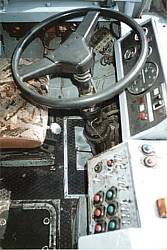 Zoltán Ádám Németh
|
|
|
Nowadays on the dashboard there are only the different meters and the switches of the
windscreen wiper. On the control panel there are 12 switches, the buttons of the doors
and the starting signal and the hole of the Bosch-key. There are separate buttons to
operate all doors above the panel, and a light which signals when somebody operates the
emergency bell (to avoid the confusion with the bell, that signals the lack of line voltage
and the derailment of the trolleys).
In the southern Hungarian city of Szeged the first trolleybus line was opened on 29th April 1979, which was the line 5 between Bartók tér and Újszeged. The network, that more or less operates today was finished by 1985. The city was purchasing mainly ZIU-9 trolleybuses between 1979 and 1986. Alltogether there were 47 such trolleybuses in the fleet of the Szeged Transportation Company (SzKV, later SzKT), with the numbers 9-111 - 9-157. In 1982, three trolleybuses were borrowed from Budapest (810, 844, 852), and in 1984 three other trolleybuses were even bought from Budapest (826, 830, 854 -> 9-140 - 9-142), which were probably refurbished at the same year.ZIU-9 trolleybuses in Szeged
The ZIU-9 trolleybuses bought by the SzKV:From 1985, the more modern ZIU-682 type trolleybuses arrived to the city (from 9-143). The most remarkable difference of these cars is the elevated rear section, which can be reached by two steps (the original ZIU-9 types have lowered rear platform behind the rear section). Similarly to the story of the Budapest ZIU-9 trolleybuses, here also many parts were changed to Ikarus types during the reconstructional works of the aging fleet. However the small differences of many parts of the trolleybuses made the fleet still colorful: e.g. for a long time here some trolleybuses were operating with the original iron-trolley bars, or the hight signalizing lamps were differently installed on many cars.* - 3 trolleybuses bought from the BKV (ex 826, 830, 854)
year 1979 1981 1982 1983 1984 1985 1986 number of new trolleybuses 9 7 10 2 1 12* 6 fleet numbers 9-111-9-119 9-120-9-126 9-127-9-136 9-137-9-138 9-139 9-140-9-151 9-152-9-157
In 1994, the 9-147 was converted to a learner trolleybus.
Today (2003) in Szeged there are only ten ZIU-9 trolleybuses still in passanger service, all of them became a refurbishment in the end of the '90s, getting green-white liveries. These are the trolleybuses 9-133, 9-137, 9-144, 9-146, 9-148 - 9-153. Some of them were reconstructed in Budapest. The very last four red ZIU-9 trolleybuses in passenger service were sold to the city of Kirow, in Russia.
Scrapping at the SzKV/SzKT:Detailed fleet dataIn the year of 2003, there are 10 ZIU-9 + 1 learner car remained in the fleet.
year 1988 1992 1993 1996 1998 2001 2002 2003 number of scrapped trolleybuses 3 4 8 3 1 12 2 3
The third trolleybus system of Hungary's post-war history was opened in the eastern city of Debrecen. The opening ceremony was on 25th April 1985, when the line 2 was put in service between Segner tér and the Köztemető (cemetary). For the opening ten ZIU trolleybuses were purchased by the Debrecen Transportation Company (DKV), from the ZIU-682UV type, which was a succesor of the ZIU-9 type at the time. Until 1989 the fleet has increased to 37 trolleybuses, amongst them were three which came used from Budapest. The arriving trolleybuses obtained fleet numbers 9-301 - 9-337.The ZIU-9 trolleybuses of Debrecen
The ZIU fleet of the DKV:In Debrecen - as in the other Hungarian cities - many parts were changed to Hungarian made Ikarus types. All trolleybuses came already with elevated rear platform, supressing the dangerous gradient of the floor in the end. The three ex-BKV cars were also converted like that (?). From the fleet, the 9-310 was scrapped because of an accident in 1990, its electrical equippment was mounted to an ex-Ikarus prototype, which became the trolleybus DKV 400.* came from Budapest (ex BKV 818, 823, 824)
year 1985 1986 1987 1988 1989 number of new trolleybuses 10 2 10 2 3* fleet numbers 9-301 - 9-320 9-321 - 9-322 9-323 - 9-332 9-333 - 9-334 9-335 - 9-337
In the second part of the '90s the city council was seriously thinking to close the trolleybus network, and purchase new gas-buses. The closure of line 4A in 2000 was the direct consequence of this politics, though the catenary is still in place. The DKV has stopped the reparation works of the ZIU trolleybuses, and started to scrap the vehicles. Despite this, still general state of the trolleybuses in Debrecen are the best maintained amongst the Hungarian cities. In 2002 it seems that the policy is changing, and some low-floor test trolleybuses were invited for demonstration. However, there are still no sign of intending to buy new cars, so the fate of the trolleybus is still uncertain in this city.
Scrapping of ZIU trolleybuses at the DKV:Detailed fleet dataIn 2003 there are 26 ZIUs in the fleet.
year 1990 1999 2000 2001 2002 number of scrapped vehicles 1 2 1 2 5